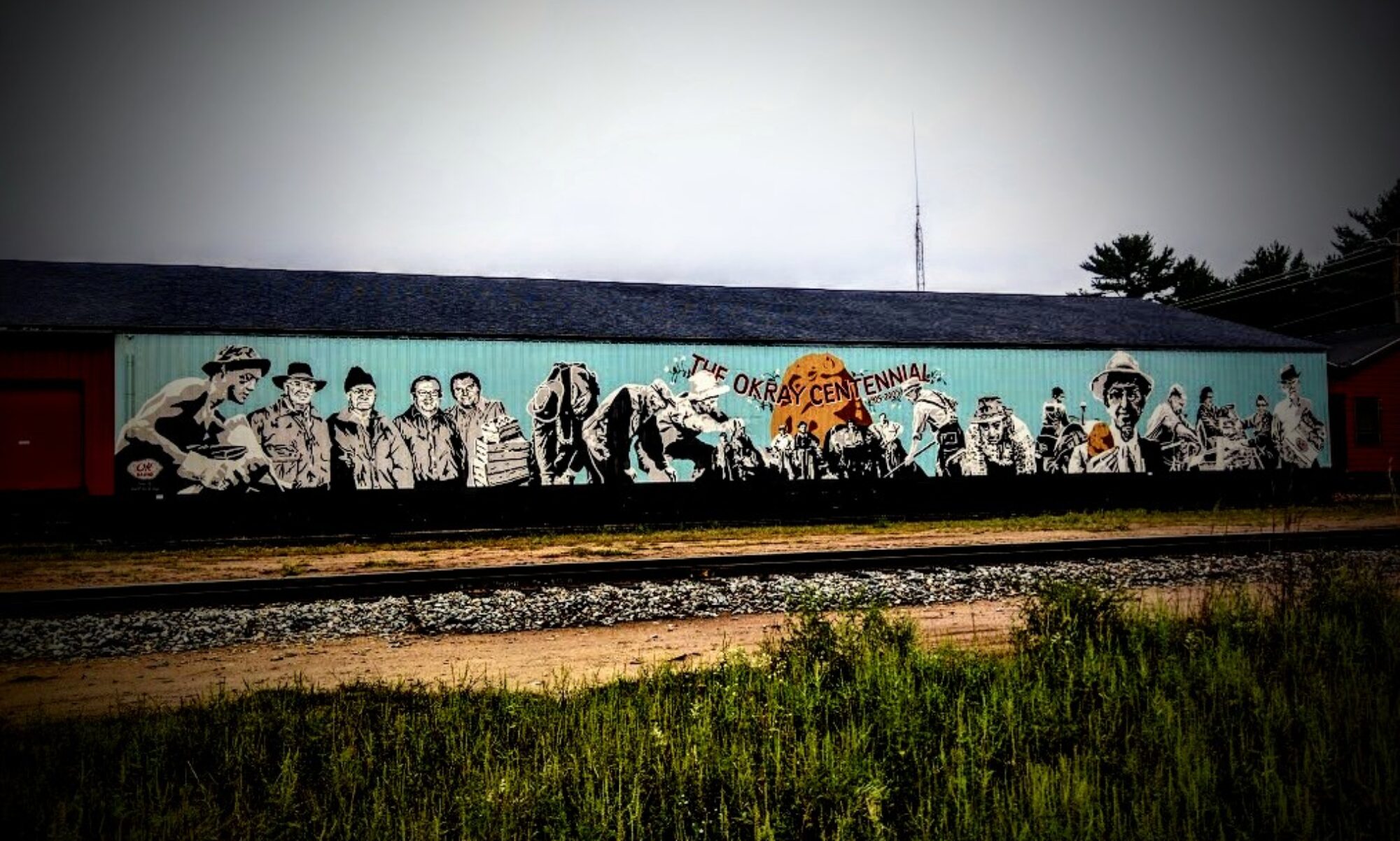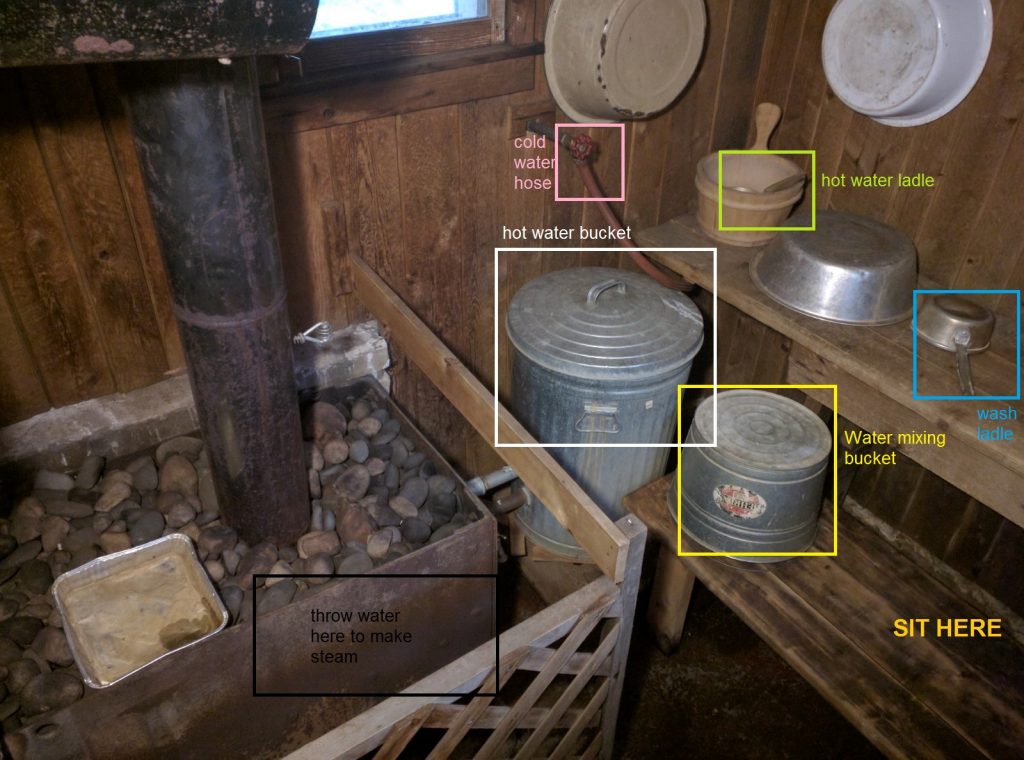This was an unhealthy trip. And not because of the local beer, porketta, potica, and pasties.
Okay, I’m only kidding, I didn’t have potica (a sweet Slovenian bread). And it wasn’t unhealthy because of the foods I ate or the beer I enjoyed, which were all enjoyed in moderation (no, seriously) and weren’t that unhealthy to begin with.
The Iron Range is unhealthy because I texted Laura at least 15 times over the five days I was here saying that I never wanted to leave. The weather was somewhat accommodating, the people were friendly if curious about why a “packsacker” (outsider) was there, the roads were exceptionally nice for how far from a city of 10K+ we were (more on that later), and Lake Vermilion…well, the lead photo says a lot, no?
I was here, though, to be one of the few (we’re talking countable-on-two-hands) researchers to visit the Rudy Perpich Papers, a collection of his papers, particularly personal and campaign records, from his political career. Special thanks go here to Christopher Welter and the Iron Range Research Center staff for helping me navigate the collections and tolerating my presence there. I can’t wait to come back.
Perpich, for those not from or familiar with the history of Minnesota, served non-consecutive terms as governor of Minnesota: from November 1976 when Wendell Anderson resigned until his defeat by Independent-Republican Al Quie in the gubernatorial election of 1978, and from his return from a self-imposed quasi-exile and subsequent recapture of the governorship in 1982 when the wildly unpopular Quie declined to run for reelection and the businessman and eventual Minnesota Vikings part-owner Wheelock Whitney offered token resistance to a Midwestern state firmly rejecting Reaganomics at the local level. Perpich returned from working for Control Data Corporation in Vienna, declared his candidacy in early 1982, and defeated the DFL-endorsed candidate, Attorney General Warren Spannaus, in a heated September primary in which the entirety of the Iron Range seemed to flood the polls in support of its chosen Hibbing dentist (and Marquette graduate)! In 1986 Perpich waxed conservative Tracy (Independent-)Republican Cal Ludeman, but in one of the wackiest elections I study, in 1990 he opted to run for a FOURTH (kind of) term, saw off DFL stalwart (and his former employee) Mike Hatch in a primary, and then faced a pro-choice Independent-Republican (primary runner-up State Auditor Arne Carlson) who ran a write-in campaign just weeks before the general election when primary winner Jon Grunseth (a more conservative Independent-Republican) dropped out after allegations surfaced that in 1981 he had swum naked in a pool with underage girls.
You got all that?
Perpich lost to Carlson by 3%.
The Research
Collections
Rudy Perpich Papers (100%)
Findings
To know Perpich, know the Range. It was tough to decide where to begin, because there is so much to say about Rudy Perpich. But to understand Rudy is to understand the culture of the Iron Range, build around extraction industries, especially mining iron ore and logging. And that’s something I don’t think I can ever fully do. I’ll have to try, though.
There was an insularity to the Range, as I mentioned. I can get by in casual conversation, given that my last name looks Finnish (double ‘a’, after all), and I’ve been told I have a bit of a Minnesotan accent. But I couldn’t fake being stunned by the sheer size of the pit mines, wowed by the beauty of the lakes and the drive, isolated while getting coffee and a donut from a downtown Chisholm bakery.
And that brings us to Rudy and the Rangers (new band name, called it). Whether I was driving on Doug Johnson Memorial Highway or Irv Anderson Memorial Highway, passing Rudy Perpich Memorial Drive, enjoying miles and miles of paved four-lane highways connecting towns of under 5,000 people, the amount of state money poured into the Range is obvious. This is a coalition that came to dominate the DFL and bring home the bacon while remaining suspicious of “packsackers.” Only Paul Wellstone, as Iron Range historian Pam Brunfelt notes, was able to transcend region and become tuteshi (“one of us”) to the Rangers.[1]
This is all a very long way of saying “the political culture of the Range matters.” And it was woefully misunderstood, misinterpreted, or (worst) willingly ignored by Metro- and outstate-area DFL activists who advanced their own agendas and discounted the willingness of Range voters to turn on their party. They did in the DFL Senate primary in 1978, backing Bob Short over Minneapolis liberal Donald Fraser, and they proved willing to do it over and over again.
The DFL in the 80s was the Metro against the rest of the state. Perpich and the Rangers played this game better than anyone else. Perpich pitted the outstate laborers–miners, loggers, farmers, packers–against Metro liberals, and it worked. Take, for example, his 1985 speech to the DFL convention:
Tragically, we face a growing problem in rural Minnesota. Just as most of the state is starting to come back, many of our sisters and brothers in rural Minnesota are suffering. Because of the federal government’s failed farm policies, decent, hard-working farm families are being driven from their farms… And what is the cause of this crisis? Is it because of farmers have suddenly forgotten how to grow crops and manage their farms? Of course not. It’s because the federal government has abandoned the farmer. Just as it abandoned the steelworker and the forest and lumber workers.” … “We know now that we must direct our own future. There will be no help from Washington. That’s all right. We can do it. We will do it as Minnesotans always have: Through sound policies and hard work.”[6]
When Minnesotans lost their jobs, Perpich quickly moved to put them back to work or claim credit for new jobs’ creation. He did it well, marshalling outstate (mostly Iron Range) support against DFL endorsee Warren Spannaus in the 1982 DFL primaries, upstart St. Paul Mayor George Latimer (we’ve talked about him before) in 1986, and longtime party servant Mike Hatch in 1990. It was this coalition–farmer and laborer–that propelled Perpich’s wing of the DFL through the eighties.
Perpich called shots and the state followed along. I’ve talked before about Perpich’s record as an economic leader for the state of Minnesota, but this look into his papers revealed just how idiosyncratic and off-the-cuff his leadership style was. In October 1989 he commissioned a project called “Moving Minnesota Forward,” giving department heads a three- to five-day turn-around to define their accomplishments since 1982 and visions for the next four years of Minnesota.[4] While he already had a reputation for burning the midnight oil and flying by the seat of his pants, his vision for the state’s economy always involved innovation and creativity, be it a chopsticks factory in the Minnesota Northwoods or a Minnesotan-Soviet research-and-development partnership that brought Mikhail Gorbachev to Saint Paul in June 1990 [5].
Women abandoned Perpich in 1990, but it was a long time coming. Staffer Nina Rothchild wrote to Perpich in August 1990, though, suggesting that, even in the wake of close Perpich adviser Terry Montgomery being accused of sexual harassment, it might not be too late to earn women’s votes:
“I believe the ‘women’s vote’ is still very much up for grabs. Despite your position on Choice, there are many feminists who know that you have an outstanding record on other women’s issues. These include your appointments to the bench, your selection of Marlene Johnson as lieutenant governor, and your many women cabinet appointees (and, of course, pay equity). I think in order to capture these votes, you need to take a very strong stand on Terry Montgomery and the sexual harassment issue. This is a real gut issue for many women. Sexual harassment signals to all of us our vulnerability and lack of power. Simply being ‘against’ sexual harassment does not seem to send a strong enough message.”[2]
Perpich and groups like the DFL Feminist Caucus, though, had been at odds since his signature to an abortion restriction bill and firing of legislative liaison Ronnie Brooks in May 1978. While the DFL emerged from its 1982 endorsing Warren Spannaus and proud of a vocal plank supporting reproductive rights, the DFLFC decried the centrism of party chair Mike Hatch and the social conservatism of outstate, especially Iron Range, interests:
“For the ‘Centrists,’ a group which was organized by Party Chair Mike Hatch and which refers to pro-choice organizers and feminists as ‘single-issue,’ ‘divisive,’ ‘bad for the party,’ and ‘anti-DFL,’ let’s review what happened concerning the abortion issue at the convention.
The DFL now has an on-going platform with a reproductive rights plank. This plank does not include provisionary language to reflect anti-choice sentiments. This is so in spite of efforts to exclude abortion rights from the platform entirely ‘in the interests of party unity.’ … In short, an overwhelming number of delegates were pro-choice, so there was no need to debate the issue.”[3]
Confronted with a pro-choice Independent-Republican and pro-life DFLer in 1990, for many of these women the choice was easy. Perpich lost the urban and suburban female vote in 1990, in a culmination of 14 years of antagonism between him and the feminist wing of the DFL.
The City Region
There’s no way to talk about the Iron Range as one city, let alone one stretch of highway or string of lakes. And that’s not even mentioning the apparent Hibbing-Virginia rivalry that I learned about. I was traveling up and down the Mesabi Range, a 100-mile stretch of iron ore deposits from Grand Rapids in the southwest to Babbitt in the northeast. My lodging was closest to Tower, MN, and the archive was located in Chisholm.

The Lodging
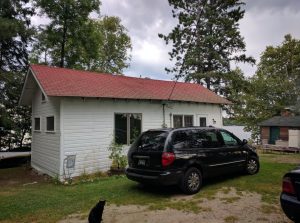
For both my trips to the Range, I’m incredibly fortunate. You’ll see that in the coming weeks as I live in a tent for various stretches in a couple North Dakota and North Woods locales. This week, I was blessed to stay with our family friends, Tom and Ann, at their cabin on Lake Vermilion.
Pretty scenic, no? They were careful to warn me ahead of time that this would be “rustic,” meaning no Wifi, possibly no cell service, brushing my teeth from bottled water, and using nature or a satellite (they moved on from the outhouse, I was told) when, well, nature called.

I found a way to manage, believe it or not.
This cabin has been in Tom’s family for 70+ years (he’s originally from nearby Virginia). It’s old, with the quirks that come with an old house. As such, I stayed in the attic,
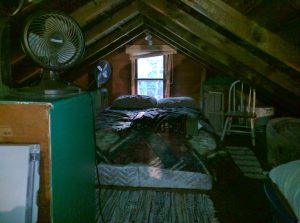
a cluster of box springs and mattresses that gets incredibly hot and has incredibly low ceilings.
This isn’t a complaint, mind you; but rather a statement that I broke a sweat doing a Hunchback of Notre Dame walk the 20 feet from the stairs to my bed. Once I opened both windows and got a nice cross breeze, it was marvelous for sleeping. I even had the pleasure of being woken up by Moon, Tom and Ann’s cat, who would come to the attic as soon as Tom was out of bed (and would no longer give Moon attention) and come paw at me until I woke up and petted him.

Again: not a complaint. I love cats, and Moon is friendlier than almost any cat I’ve ever met.
That, however, paled in comparison to the “full experience” I was treated to on Tuesday morning, when Tom prepared the sauna (pronounced “SOW-nuh,” apparently) for my use. No running water means that’s where you perform your daily ablutions: There’s a furnace of sorts where wood is fed in through a small door located in the prep room outside the actual steam room. Assorted things go there, but even my towel for drying off came in with me — or rather, it had been there overnight (heating the sauna makes the towel warm, fluffy, and dry).
I was very, very concerned I was going to commit some Finnish faux pas like using too much hot water or leaving the door open or failing to lather, rinse, and repeat as necessary (I don’t know what “necessary” means to a Finn).
An aside on that: Tom informed me of a Finnish concept called sisu, which is one of those “no translation” words like Kummerspeck in German, but that roughly means a lifestyle of constant guts and perseverance. (Any Finns reading this blog: please don’t “at” me. I’m trying here.) You take things as they come, Tom informed me; luckily, I’d not committed any infraction worthy of a polite correction (that I know of…maybe Tom is really into silent sisu). I was, after all, a “pack-sacker,” which is a non-native but apparently also just a nicer way of saying carpetbagger. Unless you’re Paul Wellstone you don’t ever become tuteshi (“one of us”) on the Range; you just hope for quiet, burdened acceptance.
That was a lengthy aside, but I think a relatively important one in explaining just how localistic (and at times incredibly insular and besieged) the Range mindset is. You see that in the Perpich machine’s interaction with the Metro-based DFL elite, and it’s never quite gone away.
Anyways, in my narration I think I’m still in the sauna. And it’s not just like a hotel sauna. Sure, you sit. You sweat. You put water on the rocks and it goes “sssssssss” and steams. You sweat more. But there’s the heavenly smell of burning wood wafting through the sauna, giving you a sense of peace as it rains outside. I faced the usual sauna benches, the furnace covered in rocks, the superheated water barrel, the hose, the dipper, the mixing bucket, and the washing dipper. That’s a lot; here’s an annotated picture of the things to consider when in the sauna:
You’re going to experience the rain outside, because part of the enjoyment of the sauna is working up a nice 15-20 minute sweat, then taking a plunge into Lake Vermilion straight off the dock before returning to wash up.
Now, the first morning I was in the sauna I opted to just walk down the ladder into 3 feet of water–not gingerly or afraid of the water, as Tom can corroborate, but in keeping with my personal decision to rarely run, let alone run shirtless down a dock that’s still coated in dew to plunge into an unfamiliar lake with rocky outcroppings. The water was a little chilly, obviously, but a welcome and refreshing kind of cold that woke me up. I ducked under, swam the 10 yards to the not-floated-out raft, and returned to the dock to adjourn to the sauna once more.
In there, you essentially perform the “Navy shower,” but you mix the water yourself: dipper from the heated barrel into the wash bucket (repeat as necessary). Put the hose in the bucket, turn it on and titrate the water in the wash bucket to a nice, warm temperature that, unlike the water in the barrel, will not make the rest of my skin look like my left forearm. From there you lather, rinse, and repeat as necessary. It is perhaps the most relaxing, cleanest 30 minutes I’ve ever experienced. Tom swears it’s also the best shave you’ve ever had–as I am currently trying to look about as off-putting as possible, I did not shave (sorry, Laura).
This will be easily the longest “lodging” section I write, and I could go on for another 500 words. But I will spare you stories of me watching the Twins sweep the Brewers, sitting on the dock at 1:30am when I couldn’t sleep, and seeing the most economical master bedroom/former sauna ever. There was so much unique about this trip that, if you asked me about it, I would be able to go on and on for a half hour.
The last thing I will mention about the cabin is the wonderful hospitality of not only Tom and Ann (again, thank you both so much!) but also their neighbors, Bob and Kathy. They hosted us consecutive nights for beers on the patio, crackers and cheese, and storytelling–sometimes about what I was finding in the archives, but mostly about growing up on the Range. And that’s just the way I wanted it.
The Sightseeing
Most of my stops were short but sweet this time around (I’ll be back at the end of August). Because I got to Chisholm by about 9:30 the first morning, half an hour before the archive opened at 10, I decided to stop at the Black Bear Bakery, right on Main Street, Chisholm, for a donut and some coffee.
 You might notice that the only picture I’ve included is of the exterior of the building. That’s because, upon walking inside in what I can loosely describe as “18 holes of golf casual” with flip-flops, I stuck out like the pack-sacker I am. Think “record scratch” in the dance club, complete with the nice girl behind the bar offering to get the coffee from the pot on the other side of the seating area because she could tell I wasn’t from there. The rest of the bakery (all six tables) was full of middle-aged to senior men, sipping black coffee from mismatched mugs and talking about (from what I could overhear) the mines, the new generation of guys in the union, the Chisholm football team, the weather, and probably the local gossip, too. Your classic small-town bakery, except I’ve never felt as out-of-place as I did in this one–and my accent was probably most at home here, too!
You might notice that the only picture I’ve included is of the exterior of the building. That’s because, upon walking inside in what I can loosely describe as “18 holes of golf casual” with flip-flops, I stuck out like the pack-sacker I am. Think “record scratch” in the dance club, complete with the nice girl behind the bar offering to get the coffee from the pot on the other side of the seating area because she could tell I wasn’t from there. The rest of the bakery (all six tables) was full of middle-aged to senior men, sipping black coffee from mismatched mugs and talking about (from what I could overhear) the mines, the new generation of guys in the union, the Chisholm football team, the weather, and probably the local gossip, too. Your classic small-town bakery, except I’ve never felt as out-of-place as I did in this one–and my accent was probably most at home here, too!
Chisholm itself is a wonderfully-quaint downtown, but with a beautiful causeway built across Longyear Lake, which hems in the east side of the central city.  The flags lining the causeway, as far as I could tell, represented the nationalities of the men and women who settled on the Iron Range and filled the mines. Even though it was a dreary, windy morning, it was a cool sight to see.
The flags lining the causeway, as far as I could tell, represented the nationalities of the men and women who settled on the Iron Range and filled the mines. Even though it was a dreary, windy morning, it was a cool sight to see.
Then, because this is northern Minnesota and of course it’s got its place in some sort of national lore, you’re greeted by this large painted wall:

I wasn’t as good about taking pictures during this trip, and I’m already over 3300 words as I write this, so I’ll recount a couple of my favorite stops, briefly:
Wuori. After being incredibly confused as to why “Wuori” was showing up on my Snapchat filters when I hadn’t seen any city with that name, fate intervened on the first day driving back from the archives. An accident up ahead on the road meant a convoy of cards were detoured onto dirt roads through Wuori Township, where we passed a town hall and recreation area, which included a softball field and (of course) hockey rink.
Vermilion Club. The Vikings had a Thursday night preseason game, and Tom swore that I’d have to experience what some publication apparently called one of the best dive bars in America, the Vermilion Club.

It’s North Woods chic at its finest, a sprawling log cabin-style bar with Vikings and Twins memorabilia adoring the walls and Schell’s offerings, Mich Golden Light, and some local Duluth craft beer on tap. We grabbed a pizza and a pair of beers, watched the start to what will surely be another disappointing Vikings season, and enjoyed the snippets of lake gossip floating across from other tables.
The other place I’m looking forward to returning to, should I ever make it back to Tower, MN, and Tom’s cabin, is an abandoned bar and co-op gas station, situated across the highway from one another on the drive. I’m not sure if anything’s left inside, but I’d love to peek inside (with as little trespassing as possible) and take a look at a not-too-long-past relic of business on the Range.
Oh, and this is what a pastie and porketta are. They’re both very, very delicious:
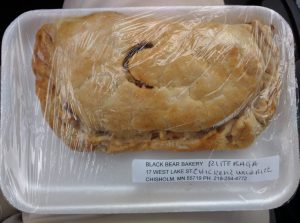
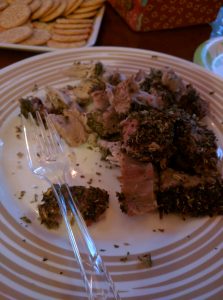
The Beer:
I actually didn’t have anything more local than Castle Danger Cream Ale this time; working until 5 in the archive meant I wanted to head straight back to the cabin, and the nearest brewery was another 25 minutes past the cabin, in Ely, MN. Maybe next time.
What’s Next?
I’ll hopefully have updates coming soon: I made it to Grand Forks, ND, and followed it up with a 2-day trip to Manitoba, but then I skipped my trip to Bismarck, ND, opting for River Falls, WI, and some closer-to-home time instead. The last week of August will be spent up on the Range again, followed by a brief camping trip to La Crosse, WI. Then begins the challenge of scaling my regional focus up to national relevance: I fly down to Atlanta to do research in the Jimmy Carter Papers for two and a half weeks.
Past Trips
Pierre
Iowa City
Bloomington
St. Paul, St. Cloud
Menomonie
Milwaukee
Superior
[1] Pamela A. Brunfelt, “Political Culture in Microcosm: Minnesota’s Iron Range,” in Perspectives on Minnesota Government and Politics (Sixth Edition), eds. Steven M. Hoffman, Angela High-Pippert, and Kay Wolsborn (Boston: Pearson Custom Publishing, 2007), 30. [2] Nina Rothchild to Rudy Perpich, “Notes on the ‘Women’s Vote,'” Perpich Briefing Book for 1990, August 8, 1990. Perpich Papers, Box 1. [3] Debra S. Cottone, “To the editor: What really happened to the abortion issue,” Richfield Sun, June 30, 1982. Perpich Papers, Box 5. [4] “Accomplishments,” “Moving Minnesota Forward” project. Perpich Papers, Box 1. [5] Transcript of “Joe Begich Oral History,” Governor Rudy Perpich Oral History Project, interviewers Barbara W. Sommer and Ed Nelson, August 12, 1997. Iron Range Research Center, 2007.0064, 13. [6] Rudy Perpich, “DFL Convention Speech,” April 1985. Perpich Papers, Box 1.
